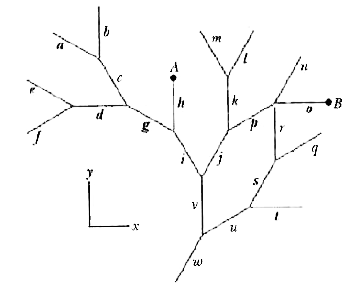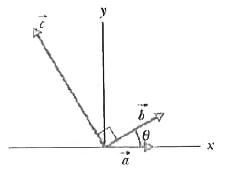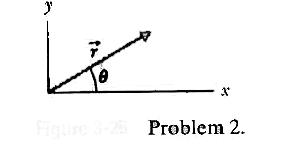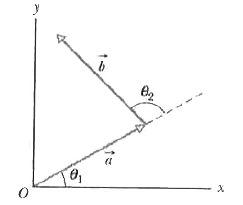PROBLEMS from RESNICK AND HALLIDAY PHYSICS Chapter 37 VECTORS for Class 12
| Class 12 | PHYSICS |
| Chapter | VECTORS |
| RESNICK AND HALLIDAY PHYSICS | PROBLEMS |
| Medium | English |
| Academic Year | 2023-2024 |
Question 4
A golf takes three putts to get the ball into the hole. The first putt displaces the ball 3.66 m north, the second 1.83 m southeast, and the thirs 0.91 m southwest. What are (a) the magnitude and (b) the direction of the displacement needed to get the ball into the hole on the first putt ? View SolutionQuestion 13
There vectors →a,→b and →c each have a magnitude of 50 m and lie in an xy plane. Their directions relative to the positive direction of the x axis are 30∘,195∘,and315∘, respectively. What are (a) the magnitude and (b) the angle of the vector →a+→b+→c, and (c ) the magnitude and (d) the angle of →a−→b−→c ? What are the (e) magnitude and (f) angle of a fourth vector →d such that (→a+→b)−(→c+→d)=0 ? View SolutionQuestion 14
In the sum →A+→b+cecC. vector →A has a magnitude of 12.0 m and is angled 40.0∘ counterclockwise from the +x direction, and vector →C has a magnitude of 16.0 m and is angled 20.0∘ counterclockwise from the -x direction. What are (a) the magnitude and (b) the angle (relative to +x) of →B ? View SolutionQuestion 15
In a game of lawn chess, where pieces are moved between the centers of squares that are each 1.00 m on edge, a knight is moved in the following way: (1) two squares forward, one square rightward, (2) two squares leftward, one square forward, (3) two squares forward, one square leftward. What are (a) the magnitude and (b) the angle (relative to "forward") of the knight's overall displacement for the series of three moves ? View SolutionQuestion 16
An explorer is caught in a whiteout (in which the snowfall is so thick that the ground cannot be distinguished from the sky) while returning to base camp. He was supposed to trave due north for 4.8km, but when the snow clears, he discovers that he actually traveled 7.8 km at 50∘ north of due east. (a) How far and (b) in what direction must he now travel to reach base camp ? View SolutionQuestion 17
An ant, crazed by the Sun on a hot Texas afternoon, darts over an xy plane scratched in the dirt. The x and y components of four consecutive darts are the following, all in centimeters: (30,0,40.0),(bx'−70.0),(−20.0,cy),(−80.0,−70.0). The overall displacement of the four darts has the xy components (−140,−20.0). WHat are (a) bxand(b)cy ? What are the (c ) magnitude and (d) angle (relative to the positive direction of the x axis) of the overall displacement ? View SolutionQuestion 23
Tpical backyard ants often create a network of chemical trails for guidance. Extending out ward from the nest, a trail branches (bifurcates) repeatedly, with 60∘ between the branches. If a roaming an chances upon a trail, it can tell the way to the nest at any branch point: If it is moving away from the nest, it has two choice of path requiring a small turn in its travel direction, either 30∘ leftward or 30∘ rightward. If it is moving toward the nest, it has only one such choice. shows a typical ant trail, with lettered straight sections of 2.0cm length and symmetric bifurcation of 60∘. Path v is parallel to the y axis. What are the (a) magnitude and (b) angle (relative to the positive direction of the superimposed x axis) of an ant's displacement from the nest (find it in the figure) if the ant enters the trail at point A ? What are the (c ) magnitude and (d) angle if it enters at point B ?
 View Solution
View SolutionQuestion 24
Here are two vectors:
→a=(4.0m)ˆi−(3.0m)ˆjand→b=(6.0m)ˆi+(8.0m)ˆj.
What are (a) the magnitude and (b) the angle (relative to ˆi) of →a ? What are (c ) the magnitude and (d) the angle of →b ? What are(e) the magnitude and (f) the angle →a+→b, of (g) teh magnitude and (h) the angle of →a=−→b, and (i) the magnitude and (i) the angle of →a−→band→a−→b ? View SolutionQuestion 26
In a cube of edge length a sits with one corncr at the origin of an xyz coordinate system. A body diagonal is a line that extends from one corner to another through the center. In unit-vector , what is the body diagonal that extends from the corner at (a) corrdianates (0,0,0), (b) corrdinates (a,0,0) (c ) coordinates (0,a,0) and (d) coordinates (a,a,0)? (e) Determine the angles that the body diagonals make with the adjacent edges . (f) Determine the length of the boedy diagonals in terms of a.
 View Solution
View SolutionQuestion 33
Displacement →d1 is in the yz plane 63.0∘ from the positive direction of the y axis, has a positive z component , and has a magnitude of 4. 80 m. Displacement →d2 is in the xz plane 30.0∘ from the positive direction of the x axis, has a positive z component, and has magnitude 1.40m. What are (a) →d1.→d2, (b)→d1x→d1,and (c ) the angle between →d1and→d2 ? View SolutionQuestion 34
The three vectors in have magnitudes a=3.00m,b=4.00m,andc=10.0mand angle θ=30.0∘. What are (a) the x component and (b) the y component of →a, (c ) the x component and (d) the y component of →b, and (e) the x component and (f) the y component of →c ? If →c=p→a+qb, what are the values of (g) p and (h) q ?
 View Solution
View Solution


